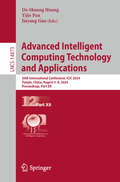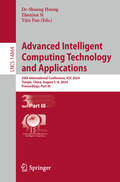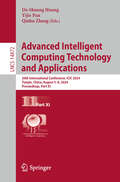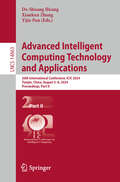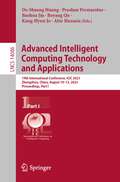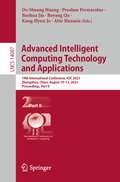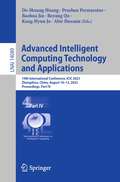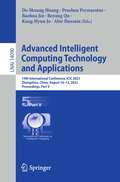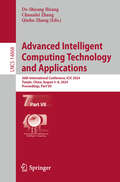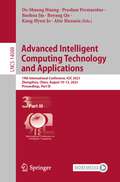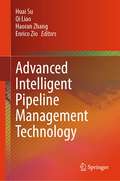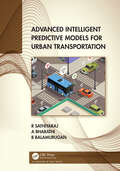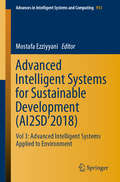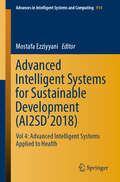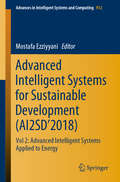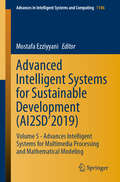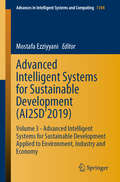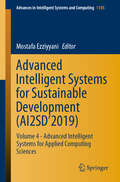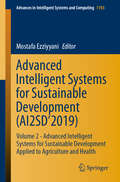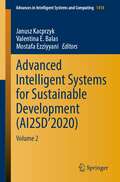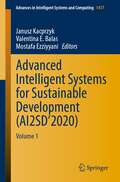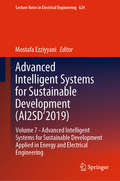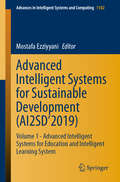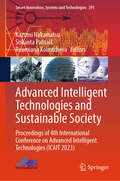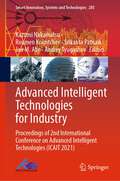- Table View
- List View
Advanced Intelligent Computing Technology and Applications: 20th International Conference, ICIC 2024, Tianjin, China, August 5–8, 2024, Proceedings, Part XII (Lecture Notes in Computer Science #14873)
by De-Shuang Huang Yijie Pan Jiayang GuoThis 13-volume set LNCS 14862-14874 constitutes - in conjunction with the 6-volume set LNAI 14875-14880 and the two-volume set LNBI 14881-14882 - the refereed proceedings of the 20th International Conference on Intelligent Computing, ICIC 2024, held in Tianjin, China, during August 5-8, 2024. The total of 863 regular papers were carefully reviewed and selected from 2189 submissions. This year, the conference concentrated mainly on the theories and methodologies as well as the emerging applications of intelligent computing. Its aim was to unify the picture of contemporary intelligent computing techniques as an integral concept that highlights the trends in advanced computational intelligence and bridges theoretical research with applications. Therefore, the theme for this conference was "Advanced Intelligent Computing Technology and Applications". Papers that focused on this theme were solicited, addressing theories, methodologies, and applications in science and technology.
Advanced Intelligent Computing Technology and Applications: 20th International Conference, ICIC 2024, Tianjin, China, August 5–8, 2024, Proceedings, Part III (Lecture Notes in Computer Science #14864)
by De-Shuang Huang Yijie Pan Zhanjun SiThis 13-volume set LNCS 14862-14874 constitutes - in conjunction with the 6-volume set LNAI 14875-14880 and the two-volume set LNBI 14881-14882 - the refereed proceedings of the 20th International Conference on Intelligent Computing, ICIC 2024, held in Tianjin, China, during August 5-8, 2024. The total of 863 regular papers were carefully reviewed and selected from 2189 submissions. This year, the conference concentrated mainly on the theories and methodologies as well as the emerging applications of intelligent computing. Its aim was to unify the picture of contemporary intelligent computing techniques as an integral concept that highlights the trends in advanced computational intelligence and bridges theoretical research with applications. Therefore, the theme for this conference was "Advanced Intelligent Computing Technology and Applications". Papers that focused on this theme were solicited, addressing theories, methodologies, and applications in science and technology.
Advanced Intelligent Computing Technology and Applications: 20th International Conference, ICIC 2024, Tianjin, China, August 5–8, 2024, Proceedings, Part XI (Lecture Notes in Computer Science #14872)
by De-Shuang Huang Yijie Pan Qinhu ZhangThis 13-volume set LNCS 14862-14874 constitutes - in conjunction with the 6-volume set LNAI 14875-14880 and the two-volume set LNBI 14881-14882 - the refereed proceedings of the 20th International Conference on Intelligent Computing, ICIC 2024, held in Tianjin, China, during August 5-8, 2024. The total of 863 regular papers were carefully reviewed and selected from 2189 submissions. This year, the conference concentrated mainly on the theories and methodologies as well as the emerging applications of intelligent computing. Its aim was to unify the picture of contemporary intelligent computing techniques as an integral concept that highlights the trends in advanced computational intelligence and bridges theoretical research with applications. Therefore, the theme for this conference was "Advanced Intelligent Computing Technology and Applications". Papers that focused on this theme were solicited, addressing theories, methodologies, and applications in science and technology.
Advanced Intelligent Computing Technology and Applications: 20th International Conference, ICIC 2024, Tianjin, China, August 5–8, 2024, Proceedings, Part II (Lecture Notes in Computer Science #14863)
by De-Shuang Huang Yijie Pan Xiankun ZhangThis 13-volume set LNCS 14862-14874 constitutes - in conjunction with the 6-volume set LNAI 14875-14880 and the two-volume set LNBI 14881-14882 - the refereed proceedings of the 20th International Conference on Intelligent Computing, ICIC 2024, held in Tianjin, China, during August 5-8, 2024. The total of 863 regular papers were carefully reviewed and selected from 2189 submissions. This year, the conference concentrated mainly on the theories and methodologies as well as the emerging applications of intelligent computing. Its aim was to unify the picture of contemporary intelligent computing techniques as an integral concept that highlights the trends in advanced computational intelligence and bridges theoretical research with applications. Therefore, the theme for this conference was "Advanced Intelligent Computing Technology and Applications". Papers that focused on this theme were solicited, addressing theories, methodologies, and applications in science and technology.
Advanced Intelligent Computing Technology and Applications: 19th International Conference, ICIC 2023, Zhengzhou, China, August 10–13, 2023, Proceedings, Part I (Lecture Notes in Computer Science #14086)
by De-Shuang Huang Prashan Premaratne Baohua Jin Boyang Qu Kang-Hyun Jo Abir HussainThis three-volume set of LNCS 14086, LNCS 14087 and LNCS 14088 constitutes - in conjunction with the double-volume set LNAI 14089-14090- the refereed proceedings of the 19th International Conference on Intelligent Computing, ICIC 2023, held in Zhengzhou, China, in August 2023.The 337 full papers of the three proceedings volumes were carefully reviewed and selected from 828 submissions. This year, the conference concentrated mainly on the theories and methodologies as well as the emerging applications of intelligent computing. Its aim was to unify the picture of contemporary intelligent computing techniques as an integral concept that highlights the trends in advanced computational intelligence and bridges theoretical research with applications. Therefore, the theme for this conference was "Advanced Intelligent Computing Technology and Applications". Papers that focused on this theme were solicited, addressing theories, methodologies, and applications in science and technology.
Advanced Intelligent Computing Technology and Applications: 19th International Conference, ICIC 2023, Zhengzhou, China, August 10–13, 2023, Proceedings, Part II (Lecture Notes in Computer Science #14087)
by De-Shuang Huang Prashan Premaratne Baohua Jin Boyang Qu Kang-Hyun Jo Abir HussainThis three-volume set of LNCS 14086, LNCS 14087 and LNCS 14088 constitutes - in conjunction with the double-volume set LNAI 14089-14090- the refereed proceedings of the 19th International Conference on Intelligent Computing, ICIC 2023, held in Zhengzhou, China, in August 2023. The 337 full papers of the three proceedings volumes were carefully reviewed and selected from 828 submissions. This year, the conference concentrated mainly on the theories and methodologies as well as the emerging applications of intelligent computing. Its aim was to unify the picture of contemporary intelligent computing techniques as an integral concept that highlights the trends in advanced computational intelligence and bridges theoretical research with applications. Therefore, the theme for this conference was "Advanced Intelligent Computing Technology and Applications". Papers that focused on this theme were solicited, addressing theories, methodologies, and applications in science and technology.
Advanced Intelligent Computing Technology and Applications: 19th International Conference, ICIC 2023, Zhengzhou, China, August 10–13, 2023, Proceedings, Part IV (Lecture Notes in Computer Science #14089)
by De-Shuang Huang Prashan Premaratne Baohua Jin Boyang Qu Kang-Hyun Jo Abir HussainThis three-volume set of LNCS 14086, LNCS 14087 and LNCS 14088 constitutes - in conjunction with the double-volume set LNAI 14089-14090- the refereed proceedings of the 19th International Conference on Intelligent Computing, ICIC 2023, held in Zhengzhou, China, in August 2023.The 337 full papers of the three proceedings volumes were carefully reviewed and selected from 828 submissions. This year, the conference concentrated mainly on the theories and methodologies as well as the emerging applications of intelligent computing. Its aim was to unify the picture of contemporary intelligent computing techniques as an integral concept that highlights the trends in advanced computational intelligence and bridges theoretical research with applications. Therefore, the theme for this conference was "Advanced Intelligent Computing Technology and Applications". Papers that focused on this theme were solicited, addressing theories, methodologies, and applications in science and technology.
Advanced Intelligent Computing Technology and Applications: 19th International Conference, ICIC 2023, Zhengzhou, China, August 10–13, 2023, Proceedings, Part V (Lecture Notes in Computer Science #14090)
by De-Shuang Huang Prashan Premaratne Baohua Jin Boyang Qu Kang-Hyun Jo Abir HussainThis three-volume set of LNCS 14086, LNCS 14087 and LNCS 14088 constitutes - in conjunction with the double-volume set LNAI 14089-14090- the refereed proceedings of the 19th International Conference on Intelligent Computing, ICIC 2023, held in Zhengzhou, China, in August 2023.The 337 full papers of the three proceedings volumes were carefully reviewed and selected from 828 submissions. This year, the conference concentrated mainly on the theories and methodologies as well as the emerging applications of intelligent computing. Its aim was to unify the picture of contemporary intelligent computing techniques as an integral concept that highlights the trends in advanced computational intelligence and bridges theoretical research with applications. Therefore, the theme for this conference was "Advanced Intelligent Computing Technology and Applications". Papers that focused on this theme were solicited, addressing theories, methodologies, and applications in science and technology.
Advanced Intelligent Computing Technology and Applications: 20th International Conference, ICIC 2024, Tianjin, China, August 5–8, 2024, Proceedings, Part VII (Lecture Notes in Computer Science #14868)
by De-Shuang Huang Chuanlei Zhang Qinhu ZhangThis 13-volume set LNCS 14862-14874 constitutes - in conjunction with the 6-volume set LNAI 14875-14880 and the two-volume set LNBI 14881-14882 - the refereed proceedings of the 20th International Conference on Intelligent Computing, ICIC 2024, held in Tianjin, China, during August 5-8, 2024. The total of 863 regular papers were carefully reviewed and selected from 2189 submissions. This year, the conference concentrated mainly on the theories and methodologies as well as the emerging applications of intelligent computing. Its aim was to unify the picture of contemporary intelligent computing techniques as an integral concept that highlights the trends in advanced computational intelligence and bridges theoretical research with applications. Therefore, the theme for this conference was "Advanced Intelligent Computing Technology and Applications". Papers that focused on this theme were solicited, addressing theories, methodologies, and applications in science and technology.
Advanced Intelligent Computing Technology and Applications: 19th International Conference, ICIC 2023, Zhengzhou, China, August 10–13, 2023, Proceedings, Part III (Lecture Notes in Computer Science #14088)
by Prashan Premaratne De-Shuang Huang Kang-Hyun Jo Abir Hussain Boyang Qu Baohua JinThis three-volume set of LNCS 14086, LNCS 14087 and LNCS 14088 constitutes - in conjunction with the double-volume set LNAI 14089-14090- the refereed proceedings of the 19th International Conference on Intelligent Computing, ICIC 2023, held in Zhengzhou, China, in August 2023. The 337 full papers of the three proceedings volumes were carefully reviewed and selected from 828 submissions. This year, the conference concentrated mainly on the theories and methodologies as well as the emerging applications of intelligent computing. Its aim was to unify the picture of contemporary intelligent computing techniques as an integral concept that highlights the trends in advanced computational intelligence and bridges theoretical research with applications. Therefore, the theme for this conference was "Advanced Intelligent Computing Technology and Applications". Papers that focused on this theme were solicited, addressing theories, methodologies, and applications in science and technology.
Advanced Intelligent Pipeline Management Technology
by Huai Su Qi Liao Haoran Zhang Enrico ZioThis book summarizes the advanced intelligent pipeline management technologies. The text discusses the main challenges of how to define and reinvent data-driven intelligent pipeline systems by studying scheduling-operation- safety management systems. Additionally, within an all-around intelligent pipeline system technology development framework, this book characterizes the scientific problems of intelligent pipeline system services among different processes, such as scheduling, demand-side management, operation condition monitoring, safety analysis, fault detection, etc. This book also introduces the existing positive and successful intelligent pipeline system projects that can be identified in the studied domain, and how can they be best applied for practical success. The text is supported by informative illustrations and case studies so that practitioners can use the book as a toolbox to improve understanding in applying the novel technologies into intelligent pipeline system management and development.
Advanced Intelligent Predictive Models for Urban Transportation
by R. Sathiyaraj A Bharathi Balamurugan BalusamyThe book emphasizes the predictive models of Big Data, Genetic Algorithm, and IoT with a case study. The book illustrates the predictive models with integrated fuel consumption models for smart and safe traveling. The text is a coordinated amalgamation of research contributions and industrial applications in the field of Intelligent Transportation Systems. The advanced predictive models and research results were achieved with the case studies, deployed in real transportation environments. Features: Provides a smart traffic congestion avoidance system with an integrated fuel consumption model. Predicts traffic in short-term and regular. This is illustrated with a case study. Efficient Traffic light controller and deviation system in accordance with the traffic scenario. IoT based Intelligent Transport Systems in a Global perspective. Intelligent Traffic Light Control System and Ambulance Control System. Provides a predictive framework that can handle the traffic on abnormal days, such as weekends, festival holidays. Bunch of solutions and ideas for smart traffic development in smart cities. This book focuses on advanced predictive models along with offering an efficient solution for smart traffic management system. This book will give a brief idea of the available algorithms/techniques of big data, IoT, and genetic algorithm and guides in developing a solution for smart city applications. This book will be a complete framework for ITS domain with the advanced concepts of Big Data Analytics, Genetic Algorithm and IoT. This book is primarily aimed at IT professionals. Undergraduates, graduates and researchers in the area of computer science and information technology will also find this book useful.
Advanced Intelligent Systems for Sustainable Development: Vol 3: Advanced Intelligent Systems Applied To Energy (Advances in Intelligent Systems and Computing #912)
by Mostafa EzziyyaniThis book gathers papers presented at the International Conference on Advanced Intelligent Systems for Sustainable Development (AI2SD-2018), which was held in Tangiers, Morocco on 12–14 July 2018. It highlights how advanced intelligent systems have successfully been used to develop tools and techniques for modeling, prediction and decision support in connection with the environment. <p><p> Though chiefly intended for researchers and practitioners in advanced intelligent systems for sustainable development, the book will also be of interest to those working in environment and the Internet of Things, environment and big data analysis, summarization, prediction, remote sensing & geo-information, geophysics, marine and coastal environments, and sensor networks for environment services.
Advanced Intelligent Systems for Sustainable Development: Vol 4: Advanced Intelligent Systems Applied to Health (Advances in Intelligent Systems and Computing #914)
by Mostafa EzziyyaniThis book gathers papers presented at the International Conference on Advanced Intelligent Systems for Sustainable Development (AI2SD-2018), which was held in Tangiers, Morocco on 12–14 July 2018. Highlighting the latest research and advances in the field of healthcare, it shares essential insights into the health sector, and is intended to stimulate further discussion and promote closer interdisciplinary collaboration among researchers and health professionals.
Advanced Intelligent Systems for Sustainable Development: Vol 2: Advanced Intelligent Systems Applied to Energy (Advances in Intelligent Systems and Computing #912)
by Mostafa EzziyyaniThis book gathers papers presented at the International Conference on Advanced Intelligent Systems for Sustainable Development (AI2SD-2018), which was held in Tangiers, Morocco on 12–14 July 2018. In addition to the latest research in the field of energy, it offers new solutions, tools and effective techniques, and provides essential information on smart grids, renewable and economical energy. Further, it addresses modeling, storage management and decision support in the field of energy, offering a valuable guide for researchers, professionals and all those who are interested in the development of advanced intelligent systems in the energy sector.
Advanced Intelligent Systems for Sustainable Development: Volume 5 - Advances Intelligent Systems for Multimedia Processing and Mathematical Modeling (Advances in Intelligent Systems and Computing #1106)
by Mostafa EzziyyaniIn this book, the authors explore technological advances in the fields of multimedia processing and mathematical modeling by highlighting the latest research in this field, discussed at the International Conference on Advanced Intelligent Systems for Sustainable Development (AI2SD-2019), held on July 08–11, 2019 in Marrakech, Morocco. In addition to advances in architectures, networking and system support tools for multimedia and hypermedia, the book examines the role of mathematical modeling as a tool for the standardization and formulation of design, management, decision-making and optimization problems, and presents various innovative works involving advanced intelligent systems based on appropriate mathematical modeling tools and techniques. The book is intended for all actors in the educational sector, namely students, professors, academic researchers and stakeholders whose work involves multimedia system development, design and applications. It constitutes an essential forum for the exchange of ideas, approaches, and innovative techniques between these actors concerning the development of and innovation in the field of education with the I4.0 revolution. The authors of each chapter report on the state of the art and present the outcomes of their own research, laboratory experiments, and successful applications. The purpose of the book is to combine the idea of advanced intelligent systems with appropriate tools and techniques for modeling, management, and decision support in the fields of multimedia system development, design and applications.
Advanced Intelligent Systems for Sustainable Development: Volume 3 - Advanced Intelligent Systems for Sustainable Development Applied to Environment, Industry and Economy (Advances in Intelligent Systems and Computing #1104)
by Mostafa EzziyyaniThis book gathers papers from the International Conference on Advanced Intelligent Systems for Sustainable Development (AI2SD-2019), held on July 08–11, 2019 in Marrakech, Morocco, which address the environment, industry and economy, and the role of advanced intelligent systems and computing in connection with these three fields. The book includes a host of interesting studies and successful applications regarding the economy and industry, e.g. in Manufacturing, Digital Factories, Smart Supply Chain Management in Industry, Project Management in Industry, Digital Economy, Digital Business, M-commerce, Blockchain and Digital Currencies. In addition, the book highlights work that addresses the environmental aspect, covering topics such as Big Data Analysis & the Internet of Things for Environmental Management, Sensor Networks for Environmental Services, Network Interoperability in Environmental Ecosystems, Wireless Sensors and Cognitive Radio Networks, Environmental Management Computing Systems, Sustainable Mobility Solutions, Remote Sensing Applications, Geo-information & Geophysics. Addressing social, legislative and environmental aspects, the book is intended for all stakeholders in the industrial world. It will be of interest e.g. to customers, helping them improve their profits and economic profitability, and to professionals and fishermen working to evolve and optimize their supply chains, and to improve productivity, in the fiercely competitive I4.0 world. The authors of each chapter report on the state of the art and present the outcomes of their own research, laboratory experiments, and successful applications. The purpose of the book is to combine the idea of advanced intelligent systems with appropriate tools and techniques for modeling, management, and decision support in the fields of the environment, industry and economy.
Advanced Intelligent Systems for Sustainable Development: Volume 4 - Advanced Intelligent Systems for Applied Computing Sciences (Advances in Intelligent Systems and Computing #1105)
by Mostafa EzziyyaniThis book gathers papers presented at the second installment of the International Conference on Advanced Intelligent Systems for Sustainable Development (AI2SD-2019), which was held on July 08–11, 2019 in Marrakech, Morocco. It offers comprehensive coverage of recent advances in big data, data analytics and related paradigms. The book consists of fifty-two chapters, each of which shares the latest research in the fields of big data and data science, and describes use cases and applications of big data technologies in various domains, such as social networks and health care. All parts of the book discuss open research problems and potential opportunities that have arisen from the rapid advances in big data technologies. In addition, the book surveys the state of the art in data science, and provides practical guidance on big data analytics and data science. Expert perspectives are provided by authoritative researchers and practitioners from around the world, who discuss research developments and emerging trends, present case studies on helpful frameworks and innovative methodologies, and suggest best practices for efficient and effective data analytics. Chiefly intended for researchers, IT professionals and graduate students, the book represents a timely contribution to the growing field of big data, which has been recognized as one of the leading emerging technologies that will have a major impact on various fields of science and various aspects of human society over the next several decades. Therefore, the content in this book is an essential tool to help readers understand current developments, and provides them with an extensive overview of the field of big data analytics as it is practiced today. The chapters cover technical aspects of key areas that generate and use big data, such as management and finance, medicine and health care, networks, the Internet of Things, big data standards, benchmarking of systems, and others. In addition to a diverse range of applications, key algorithmic approaches such as graph partitioning, clustering and finite mixture modeling of high-dimensional data are also covered. The varied collection of topics addressed introduces readers to the richness of the emerging field of big data analytics.
Advanced Intelligent Systems for Sustainable Development: Volume 2 - Advanced Intelligent Systems for Sustainable Development Applied to Agriculture and Health (Advances in Intelligent Systems and Computing #1103)
by Mostafa EzziyyaniThis book highlights the latest research in the fields of health care and agriculture, presented at the second installment of the International Conference on Advanced Intelligent Systems for Sustainable Development (AI2SD-2019), held on July 08–11, 2019 in Marrakech, Morocco. Gathering contributions by respected researchers in the field of agriculture, the book is intended to stimulate debate in this field, and proposes new solutions, tools and effective techniques concerning various current topics in the field of agriculture, such as ICT, IoT and big data analytics for agriculture, smart systems for plant productivity, and data analytics of socio-economic dimensions for sustainable agriculture and aquaculture. With regard to the field of health, the book addresses several areas of research, including E-health services in smart environments (smart homes, smart medical institutions, smart cities), E-health and big data analysis, IoT for health, network interoperability in E-health ecosystems, current and emerging web norms and communication technologies for E-health, heterogeneity of E-health environments and platforms (sensors and actuators, heterogeneous access technologies, security), human–computer interaction, RFID and localization techniques, E-health virtual communities, and business intelligence in health care. This book is intended for academic and professional researchers, decision-makers and all stakeholders in the fields of health and agriculture whose work involves the development and improvement of this field with modern I4.0 technologies and approaches. The authors of each chapter report on the state of the art and present the outcomes of their own research, laboratory experiments, and successful applications. The purpose of the book is to combine the idea of advanced intelligent systems with appropriate tools and techniques for modeling, management, and decision support in the fields of health and agriculture.
Advanced Intelligent Systems for Sustainable Development: Volume 2 (Advances in Intelligent Systems and Computing #1418)
by Janusz Kacprzyk Mostafa Ezziyyani Valentina E. BalasThis book publishes the best papers accepted and presented at the 3rd edition of the International Conference on Advanced Intelligent Systems for Sustainable Development Applied to Agriculture, Energy, Health, Environment, Industry, Education, Economy, and Security (AI2SD’2020). This conference is one of the biggest amalgamations of eminent researchers, students, and delegates from both academia and industry where the collaborators have an interactive access to emerging technology and approaches globally. In this book, readers find the latest ideas addressing technological issues relevant to all areas of the social and human sciences for sustainable development. Due to the nature of the conference with its focus on innovative ideas and developments, the book provides the ideal scientific and brings together very high-quality chapters written by eminent researchers from different disciplines, to discover the most recent developments in scientific research.
Advanced Intelligent Systems for Sustainable Development: Volume 1 (Advances in Intelligent Systems and Computing #1417)
by Janusz Kacprzyk Mostafa Ezziyyani Valentina E. BalasThis book publishes the best papers accepted and presented at the 3rd edition of the International Conference on Advanced Intelligent Systems for Sustainable Development Applied to Agriculture, Energy, Health, Environment, Industry, Education, Economy, and Security (AI2SD’2020). This conference is one of the biggest amalgamations of eminent researchers, students, and delegates from both academia and industry where the collaborators have an interactive access to emerging technology and approaches globally. In this book, readers find the latest ideas addressing technological issues relevant to all areas of the social and human sciences for sustainable development. Due to the nature of the conference with its focus on innovative ideas and developments, the book provides the ideal scientific and brings together very high-quality chapters written by eminent researchers from different disciplines, to discover the most recent developments in scientific research.
Advanced Intelligent Systems for Sustainable Development: Volume 7- Advanced Intelligent Systems for Sustainable Development Applied in Energy and Electrical Engineering (Lecture Notes in Electrical Engineering #624)
by Mostafa EzziyyaniThis book summarizes the latest research on advanced intelligent systems in the fields of energy and electrical engineering, presented at the second edition of the International Conference on Advanced Intelligent Systems for Sustainable Development (AI2SD’2019), held in Marrakech from 8 to 11 July 2019, Morocco. This book is intended for researchers, professionals and anyone interested in the development of advanced intelligent systems in the electrical engineering sector. The solutions featured focus on three main areas: motion control in complex electromechanical systems, including sensorless control; fault diagnosis and fault-tolerant control of electric drives; and new control algorithms for power electronics converters. In addition, the book includes a range of research using new technologies and advanced approaches. Offering a platform for researchers in the field of energy to share their work related to the problem of management and optimization of energy, which is a major current concern, the book mainly focuses on areas that go hand in hand with the Industrial Revolution 4.0, such as solar energy computing systems, smart grids, hydroelectric power computing systems, thermal and recycling computing systems, eco-design intelligent computing systems, renewable energy for IT equipment, modeling green technology, and renewable energy systems in smart cities. The authors of each chapter report the state of the art in the topics addressed and the results of their own research, laboratory experiments, and successful applications in order to share the concept of advanced intelligent systems and appropriate tools and techniques for modeling, storage management, as well as decision support in the field of electrical engineering. Further, the book discusses a number of future trends and the potential for linking control theory, power electronics, artificial neural networks, embedded controllers and signal processing.
Advanced Intelligent Systems for Sustainable Development: Volume 1 - Advanced Intelligent Systems for Education and Intelligent Learning System (Advances in Intelligent Systems and Computing #1102)
by Mostafa EzziyyaniThis book contains the latest researches on advanced intelligent systems applied in the field of education presented during the second edition of the International Conference on Advanced Intelligent Systems for Sustainable Development (AI2SD’2019) held on July 08–11, 2019, in Marrakech, Morocco. The book proposes new approaches and innovative strategies for the manipulation of data and big data collected from the educational environment, exploiting the analysis tools, algorithms of artificial intelligence, and machine learning techniques, in order to extract results, which allow improving the performance and effectiveness of the education field, which is a strategic lever for sustainable development. The book deals with concepts, strategies, and approaches developed on various current axes of scientific research in the field of education, such as smart e-learning, smart education (smart classroom, smart assessment and smart teaching and learning technologies), massive open online courses (MOOC), courseware design, and development for smart learning, cloud learning, and mobile learning. The book is intended for all actors in the educational sector, namely students, professors, academic researchers, and stakeholders. It constitutes a large-scale forum for the exchange of ideas, approaches, and innovative techniques between these actors on the development and innovation of the field of education with the revolution 4.0. The authors of each chapter report the state of the art of the various topics addressed and present results of their own research, laboratory experiments, and successful applications. The purpose of this session is to share the idea of advanced intelligent systems with appropriate tools and techniques for modeling, management, and decision support in the field of education.
Advanced Intelligent Technologies and Sustainable Society: Proceedings of 4th International Conference on Advanced Intelligent Technologies (ICAIT 2023) (Smart Innovation, Systems and Technologies #391)
by Srikanta Patnaik Kazumi Nakamatsu Roumiana KountchevaThis book includes new research results of scholars from the Fourth International Conference on Advanced Intelligent Technologies (ICAIT 2023) organized by IRNet International Academic Communication Center, held during November 3–5, 2023. The book covers research work from active researchers who are working on collaboration of industry and various intelligent technologies such as intelligent technologies applicable/applied to manufacturing and distribution of industrial products, factory automation, business, etc. The topics included are all computational intelligence techniques applicable/applied to industry, intelligent techniques in data science applicable/applied to business and management, intelligent network systems applicable/applied to industrial production, intelligent technologies applicable to smart agriculture, and intelligent information systems for agriculture.
Advanced Intelligent Technologies for Industry: Proceedings of 2nd International Conference on Advanced Intelligent Technologies (ICAIT 2021) (Smart Innovation, Systems and Technologies #285)
by Kazumi Nakamatsu Roumen Kountchev Srikanta Patnaik Jair M. Abe Andrey TyugashevThe book includes new research results of scholars from the Second International Conference on Advanced Intelligent Technologies (ICAIT 2021) subtitled Intelligent Technology and Industry organized by IRNet International Academic Communication Center, held during October 15–17, 2021. The book covers research work from active researchers who are working on collaboration of industry and various intelligent technologies such as intelligent technologies applicable/applied to manufacturing and distribution of industrial products, factory automation, business, etc. The book focuses on theory, design, development, testing, and evaluation of all intelligent technologies applicable/applied to various parts of industry and its infrastructure. The topics included are all computational intelligence techniques applicable/applied to industry, intelligent techniques in data science applicable/applied to business and management, intelligent network systems applicable/applied to industrial production, intelligent technologies applicable to smart agriculture, and intelligent information systems for agriculture.
